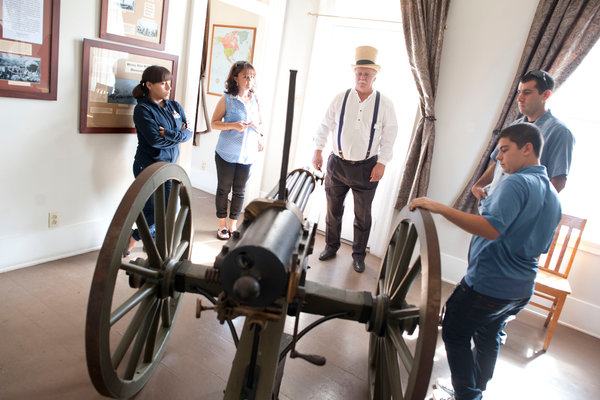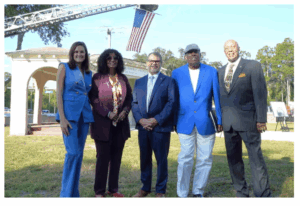LOS ANGELES — ABOUT 15 years ago, Ron Hyde was thumbing through a Civil War magazine when he came across an advertisement for a museum called Drum Barracks.
“The ad said it was located in Wilmington, Calif.,” said Mr. Hyde, who lives in Norco, about 50 miles southeast of Los Angeles. “I thought, ‘That’s got to be a typo. It must be in Delaware or North Carolina.’ ”
Intrigued, he called the number and found the state was no mistake. A Civil War museum was in Wilmington, a part of Los Angeles about 20 miles from downtown.
What is more, the museum was housed in the last surviving structure of a 22-building Union Army base.

An 1875 Gatling gun is part of an extensive display of Civil War-era weapons at the Drum Barracks Civil War Museum. Michal Czerwonka for The New York Times
“It was a revelation for me,” said Mr. Hyde, a Civil War buff since watching Ken Burns’s 1990 PBS series, “The Civil War.” “I had no idea that California was even involved in the conflict.”
Now, as a volunteer docent at Drum Barracks, he gets the same reaction from among the approximately 9,000 people who visit the obscure site each year. This little-known but fascinating story of California in the Civil War is told at the Drum Barracks Civil War Museum, part of the City of Los Angeles museum system.
Drum Barracks sits incongruously in the middle of sprawling, modern Los Angeles.
“People ask us, ‘Why did they build this in a residential neighborhood?’ ” says Susan Ogle, director of the museum.
They didn’t. When construction of Drum Barracks was complete in 1863, Los Angeles was a town of 4,400, and Wilmington was a tiny village near the harbor (now the Port of Los Angeles).
The outpost owes its existence to a chain of events in the Far West, an often overlooked theater of the Civil War. In summer 1861, a few months into the war, Confederate forces struck out into the Arizona territory from Texas. Their long-range goal was the ports, mineral resources and open lands of the lightly defended California, which was admitted into the Union in 1850. In her 2012 book “The Golden State in the Civil War” (Cambridge University Press), the historian Glenna Matthews writes that Confederate leaders viewed California, particularly the pro-secessionist southern section, as “a land of opportunity for them.”
In Southern California then was Capt. Winfield Scott Hancock, who would become a hero of the Battle of Gettysburg. He and Maj. James Henry Carleton, a cavalry officer dispatched from San Francisco to help him, chose a site a half-mile from the harbor to build a base, which was named Camp Drum. That was in late 1861. From there, in April 1862, Major Carleton’s force, the California Column, rode east to meet the Confederates. By the time the force reached the Rio Grande, the main Southern army had turned around. But the Union troops battled the rebels at Picacho Pass, about 50 miles northwest of what is now Tucson.
Back in Wilmington, an expanded base was built with the help of Phineas Banning, a local businessman who named the community he had developed after his hometown in Delaware. He donated 60 acres for what would become known as Drum Barracks.
The new base became a depot, training base and staging point for operations of the Union Army in the West. Almost 8,000 men passed through Drum Barracks during the war. In her book, Ms. Matthews cites a letter from an Army officer who called the large, well-built base “astonishing,” adding that “some of the men in our company who had seen service in the East said that they had never seen anything like it.”
No doubt one of the most astonishing sights was the 36 Levantine camels quartered there. The Army brought them from the Middle East in the 1850s for use in the desert. For the most part, they spent the war munching the grass around Drum Barracks.
A life-size iron likeness of a camel stands in front of the museum today. “The kids love it,” Ms. Ogle said.
The base was named after Richard Coulter Drum, the Union’s adjutant general based in San Francisco. A shrewd move, Ms. Ogle said, adding, “Who better to name the post after than the man who signs the checks?”
The Drum Barracks Civil War Museum could use some of that largess. “I wish we had more space,” Ms. Ogle said. “We need a visitors’ center, a children’s reading room. We can only take 15 visitors through at a time now.”
Visitors find a wealth of artifacts in the 14 rooms of the U-shaped building, which was originally the junior officers’ quarters. One of the most impressive is an 1875 Gatling gun, part of an extensive display of Civil War-era weapons, including a collection of 291 bullets. A battle flag was donated by the family of a veteran of the Battle of Vicksburg who received the Medal of Honor. Rooms are decorated to show the living conditions of soldiers and officers, featuring period pieces, like a rare 1869 Steinway piano. Drums Barracks also has a genuine drum from the 8th New York Volunteers, a library of 3,000 volumes and the artificial leg of a soldier, which was donated by his descendants.
After the post was decommissioned, the remaining building was variously the site of a minister’s home, a high school and a boardinghouse. Threatened with demolition in the 1960s, it was saved through the efforts of local preservation groups. In the 1970s, the city renovated the building, which opened as a museum in 1987.
Ms. Ogle, who joined the museum in 2000, is Drum Barracks’ second director and only full-time employee. In 2010, when her job was designated to be cut, the Civil War Trust in Washington, a national group dedicated to preservation of Civil War battlefields, wrote to the city attesting to the museum’s historical significance. Her job was saved.
“It’s a legitimate, authentic piece of American Civil War history,” said James Lighthizer, president of the Civil War Trust. “And it’s standing there in the middle of this Los Angeles neighborhood.”
–John Hanc, New York Times



